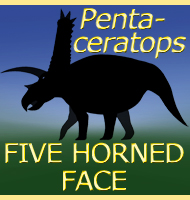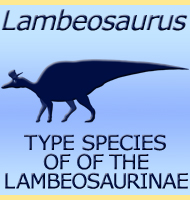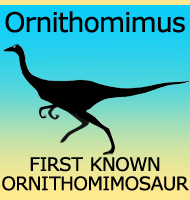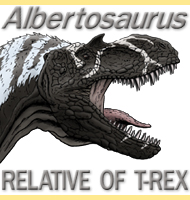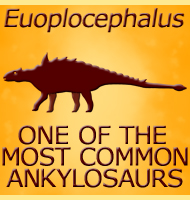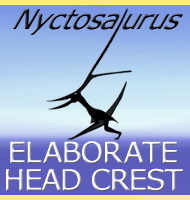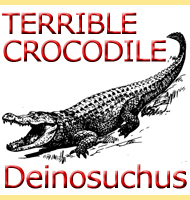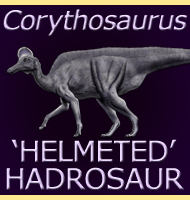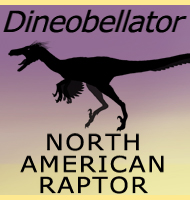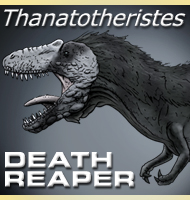


Stegoceras
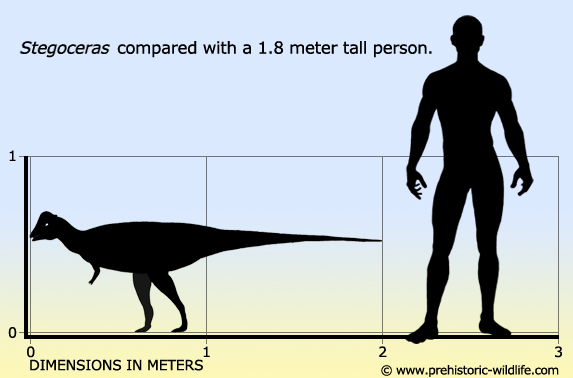
Name:
Stegoceras
(horned roof).
Phonetic: Steg-oh-seh-rass.
Named By: Lawrence Lambe - 1902.
Synonyms: Ornatotholus, Hanssuesia?
Classification: Chordata, Reptilia, Dinosauria,
Ornithischia, Pachycephalosauria.
Species: S. validum
(type), S. novomexicanum.
Diet: Herbivore.
Size: Estimated at about 2 meters long.
Known locations: Canada, Alberta - Belly River
Group and Saskatchewan - Judith River Formation. USA, Montana
- Hell Creek Formation, Judith River Formation, and New Mexico
- Fruitland Formation - Kirtland Formation.
Time period: Campanian of the Cretaceous.
Fossil representation: Multiple individuals.
Stegoceras
is one of the more common and better known pachycephalosaurs,
and one
that seems to have had a range that extended from South west/central
Canada to the south western states of the USA. The genus however
seems to have been quite a bit smaller than its more famous relative
Pachycephalosaurus.
Like
with all pachycephalosaurs, the skull of Stegoceras
is noted for
having extreme thickening which would have resulted in a dome-like
structure on top of the skull. In Stegoceras the
bone that would have
made up the dome would be around seventy-five millimetres at its
maximum thickness. The eyes are also interesting to note as the eye
sockets would have faced forwards, which means that Stegoceras
would
have also had a fairly good degree of stereoscopic vision, meaning
depth perception. Stegoceras was also once noted
as the only
ornithischian dinosaur to have gastralia (belly ribs), however
these have now been re-examined and realised to be ossified tendons.
In
1983 a species of Stegoceras named S.
browni was established as a
distinct genus named Ornatotholus. This was noted
as a flat headed
pachycephalosur, however it now seems that the flat headed forms of
pachycephalosaurs are actually the juvenile and under developed forms
of the dome-headed genera which are adults. Ornatotholus
is now
regarded as a juvenile of and hence synonym to the Stegoceras
type
species S. validum.
Also
like with other pachycephalosaurs Stegoceras was
once popularly thought
to be a ‘head butter’, the thick dome of the skull being used to
deal out and absorb impacts. This is not that widely accepted anymore
however with some studies suggesting the bone of the skull would have
actually not been strong enough to repeatedly absorb hits, others
suggesting that it was not of a correct shape to maximise impact area.
Other still suggest that ‘flank butting’, where the head was
used to give out impacts to the sides of animal would have been more
likely given the apparent fragility of the skull.
Further reading
- New genera and species from the Belly River Series
(mid-Cretaceous). - Geological Survey of Canada Contributions to
Canadian Palaeontology 3(2):25-81 - Lawrence Lambe - 1902.
Agonistic behavior in pachycephalosaurs (Ornithischia:
Dinosauria): a new look at head-butting behavior. -
Contributions to Geology 32 (1): 19–25. - Kenneth
Carpenter - 1997.
- Dinosaur gastralia: origin, morphology, and function. -
Journal of Vertebrate Paleontology 24 (1): 89–106. -
Leon P. A .M. Claessens - 2004.
- Cranial Ontogeny in Stegoceras validum
(Dinosauria:
Pachycephalosauria): A Quantitative Model of Pachycephalosaur Dome
Growth and Variation. - PLoS ONE 6 (6): e21092. - Ryan
K. Schott, David C. Evans, Mark B. Goodwin, John R.
Horner, Caleb Marshall Brown & Nicholas R. Longrich -
2011.
- Re-evaluation of pachycephalosaurids from the Fruitland-Kirtland
transition (Kirtlandian, late Campanian), San Juan Basin, New
Mexico, with a description of a new species of Stegoceras
and a
reassessment of Texascephale langstoni. -
Fossil Record 3. New
Mexico Museum of Natural History and Science, Bulletin 53:
202–215. - Steven E. Jasinski and Robert M. Sullivan -
2011.
- Squamosal Ontogeny and Variation in the Pachycephalosaurian Dinosaur
Stegoceras validum Lambe, 1902, from the Dinosaur Park Formation,
Alberta. - Journal of Vertebrate Paleontology. 32 (4): 903–913. - R. K.
Schott & D. C. Evans - 2012.
----------------------------------------------------------------------------
Random favourites
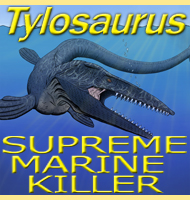 |
 |
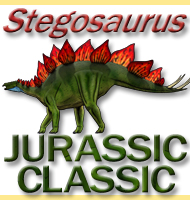 |
